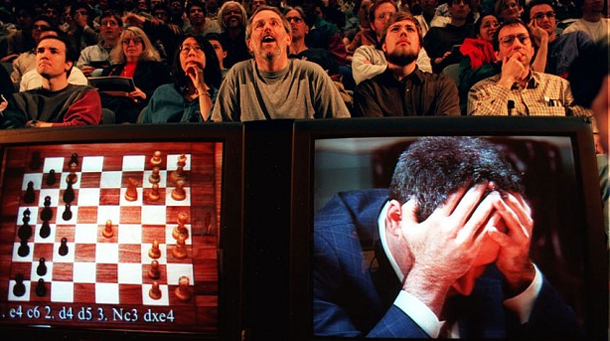
The Deep Blue team contained one grandmaster and had the input of several more.
DEEP BLUE CHESS GAME 6 SERIES
Unlike the first series, which took place in an auditorium, the 1997 series of chess games took place in a TV stadium. Chess players and fans, along with a sizable number of the general public, watched some or all of the games live on television.

The victory was not without intrigue or controversy. Deep Blue then won the final game, achieving an overall victory with a final score of 3–2. So heading into the final game, the score was tied at 2–2. Deep Blue countered with a win in the second game. Again it took place during a seven-day period, from May 10 to May 17, in 1997, in New York. The rematch occurred the following year.Īgain it was a six-match series. (Chess scoring awards 1 point to each game’s winner a draw earns each player ½ point.) Kasparov won $400,000 of the $500,000 prize the other $100,000 went to the Deep Blue team.ĭeep Blue’s developers made some improvements to the computer and challenged Kasparov again. Kasparov was declared the winner by a score of 4–2. Kasparov won three of the next five (games 2, 5, and 6), and the other two ended in a draw.

However, that was the last game the computer would win. Kasparov sat on one side of the chessboard on the other side sat a person who made the moves suggested by the computer. The six-game match occurred February 10 to February 17, in 1996, in Philadelphia. In the mid-1990s, the team declared itself ready for another challenge, and Kasparov agreed to play against the new computer. Hsu and the team at IBM went on to develop another chess-playing computer, this one named Deep Blue, after IBM’s nickname of “Big Blue.” Development of Deep Blue, with the addition to the team of grandmaster Joel Benjamin, continued for the next several years. Kasparov was the top-ranked chess player in the world for 225 out of the next 228 months, retiring in 2005. He was 22 and made headlines around the world for defeating the reigning champion, Anatoly Karpov. Kasparov in 1985 had become the youngest-ever undisputed world chess champion. The computer met its match in Kasparov the following year, however, losing both games to the Russian champion. Also working on Deep Thought were Thomas Anantharaman, Mike Browne, Murray Campbell, and Andreas Nowatzyk.ĭeep Thought, named after a computer in Douglas Adams’ famous book series The Hitchhiker’s Guide to the Galaxy, made headlines in 1988 when it defeated Danish grandmaster Bent Larsen. Hsu moved on from that to develop a computer called Deep Thought.

His chosen field of study was computer chess. Feng-hsiung Hsu (left), a computer scientist originally from Taiwan, arrived at Pittsburgh’s Carnegie Mellon University to do his graduate work in 1985. The story of this titanic struggle on a chessboard starts further back in time, in the mid-1980s. In 1997, their efforts paid off.ĭuring a one-week period in May of 1997, Kasparov and a human representative of IBM, acting on instructions from Deep Blue, squared off in a rematch of a contest that had occurred a year before. Which is why it is all the more surprising Kasparov gave up at this exact point in the game.Deep Blue was a chess-playing computer that a team of people at IBM developed to defeat the reigning world chess champion, Garry Kasparov. Kasparov had battled Deep Blue at least eleven times prior to this match (six times in 1996 and five uptil then in 1997) and had managed to win convincingly against it, albeit with some losses - but this had not deterred him before. c4 looks completely harmless in this position.Īnalyses after the match and around the time predicted the position would be roughly even for several iterations Kasparov could have held out. It was a shocking upset at the time because 19. The game is justifiably famous and is linked here.


 0 kommentar(er)
0 kommentar(er)
